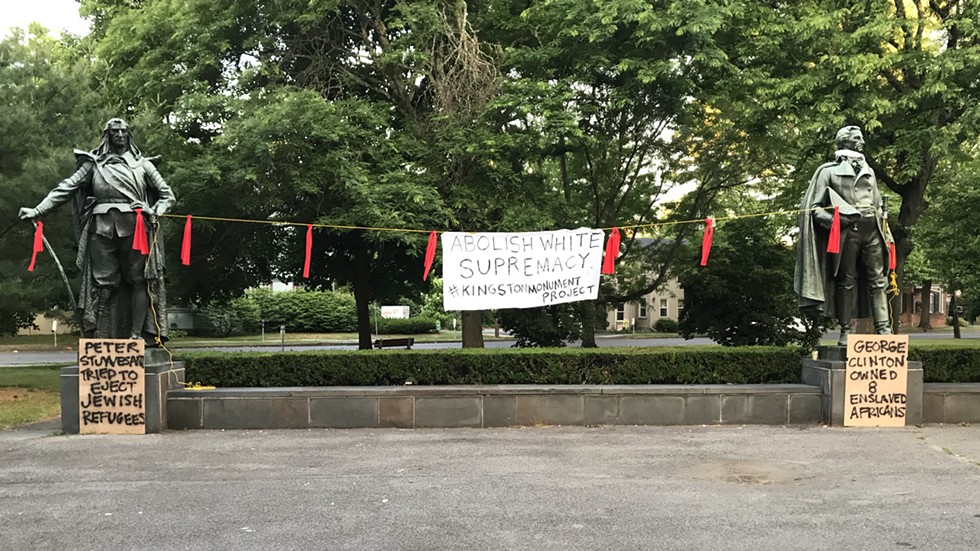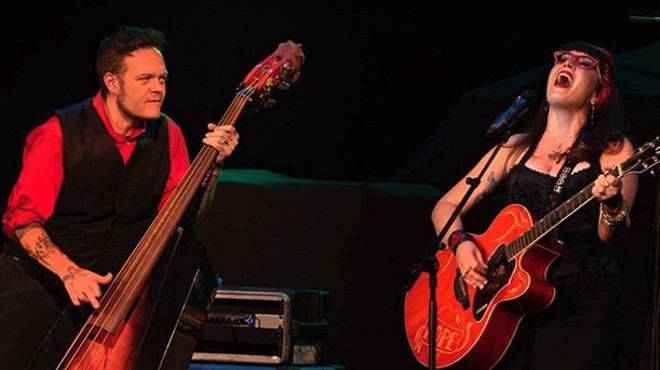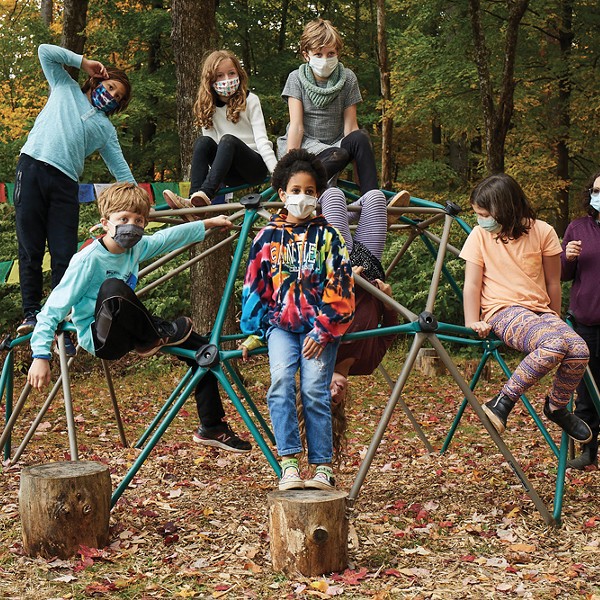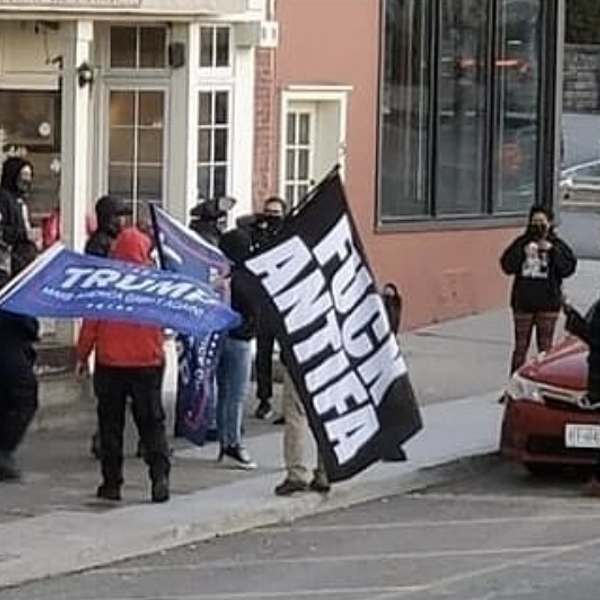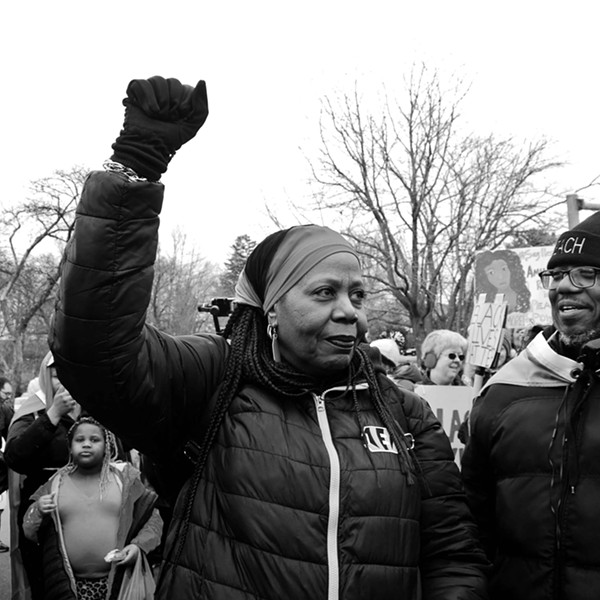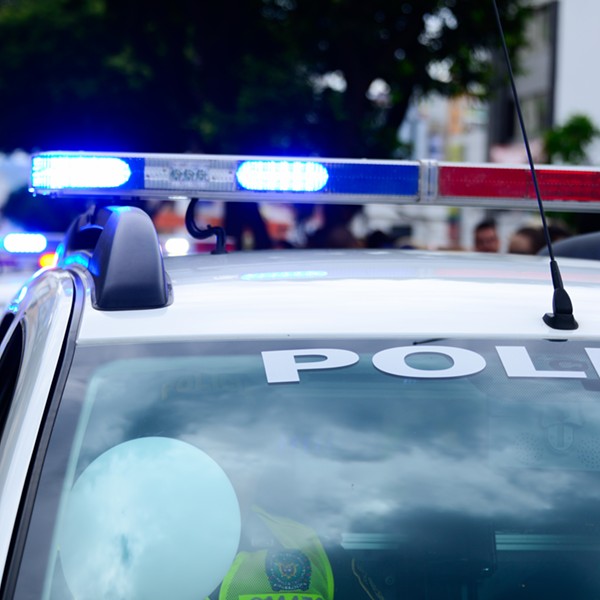On June 14, Lisa Royer was meeting with a fellow organizer and a dozen young people at Academy Green Park in uptown Kingston. The group, known as Justice for Aleesa, was getting together to plan future actions drawing attention to the victimization of Royer’s daughter, Aleesa, by local police officers in 2017 and police brutality more generally. In the shadows of Peter Stuyvesant, George Clinton, and Henry Hudson, whose statues stand at the center of the park, Royer and the others enjoyed pizza and discussed their plans.
As Royer recalls, it was without warning that a driver circling the park shouted at them: “These statues aren’t coming down, you monkeys!”
The Justice for Aleesa group, mostly people of color, were understandably upset. They had been meeting in Academy Green Park regularly but had never experienced such harassment. They had begun discussing how they should react in the future when another driver shouted: “We’re coming back with Confederate flags and putting them up on the statues!”
“I’ve never really experienced racism firsthand like that,” says Mia, one of the young people at the park. (The last names of young people have been withheld throughout this article out of concern for their personal safety.) “It’s everywhere, but I’ve never truly seen it in our hometown like that. Pretty sad how people will go the extra mile to be evil.”
Mia, Royer, and the others were at Academy Green Park to oppose police brutality, but just like that, they were sucked into another struggle, around the removal of monuments to white supremacy. The statues of Stuyvesant, Clinton, and Hudson in Kingston are just a few of the many white supremacist symbols that dot the Hudson Valley. Riding the momentum of the nationwide Black Lives Matter movement, local antiracist activists are now pushing for such symbols to be removed from public spaces. But they face backlash from bigots, who are also targeting other community members, like the Justice for Aleesa group, in retaliation.
Implicit Threats
It is difficult to pin down the exact number of monuments that glorify white supremacy in the Hudson Valley. The Southern Poverty Law Center maintains a map of Confederate memorials, which lists the Robert E. Lee Barracks at West Point, but not all white supremacist symbols are related to the Confederacy. Statues of Christopher Columbus, for example, have long been condemned for glorifying a colonizer responsible for the genocide of one to two million Taino people, who inhabited Hispaniola (modern-day Haiti and the Dominican Republic) prior to his arrival. Despite this, there are statues of Columbus across the United States, including in Newburgh, Poughkeepsie, and Mount Kisco, with many funded by the Italian-American heritage organization UNICO, which continues to defend them. (Multiple requests for comment to UNICO from The River for this article went unanswered.)
Similarly, the statues of Peter Stuyvesant, George Clinton, and Henry Hudson in Academy Green Park are monuments to white supremacy. Stuyvesant, the last Dutch director of New Netherland (today parts of New York, New Jersey, Delaware, and Connecticut), was a rabid anti-Semite who wanted to forcefully remove Jews from the colony. Clinton, the first governor of New York State, was an enslaver. And Hudson, the English navigator whose exploration of the region laid the foundation for the colonization of New Netherland, was responsible for the displacement of the Lenape people of this region, which they call “Lenapehoking.”
“These statues are symbols of traditional white supremacy and patriarchy,” says Frances Cathryn, founder of the Kingston Monument Project, which seeks their removal.
Inspired by the work of activists with Decolonize This Place?—who recently succeeded in pushing the American Museum of Natural History to remove a statue of Theodore Roosevelt flanked by two Black and Indigenous men carrying his guns?—Cathryn created a petition in early June calling on Kingston city officials to remove the statues at Academy Green Park. At the time of this writing, the petition has gathered 3,536 signatures, but, as Cathryn sees it, the issue really came to life after an article about the petition, and a series of op-eds in response, were published by the Kingston Daily Freeman.
When the Daily Freeman shared the article on its Facebook page, it garnered an explosive reaction, with more than 450 comments, many sexist and/or xenophobic in nature. The very next day is when Justice for Aleesa members were harassed at Academy Green.
“I don’t see them as unconnected, frankly,” says Cathryn of her petition and the racial harassment experienced by the Justice for Aleesa group. Royer concurs.
“The same group of folks who are against taking down the statues also don’t understand why we need police accountability,” Royer says.
With the implicit threat of white supremacist violence inherent in the statues becoming an explicit threat in the form of harassment, Cathryn felt that she needed to switch tacks. The following weekend, she and other organizers with the Kingston Monument Project decided to engage with community members at the local farmers’ market, a few blocks from Academy Green Park. Organizers publicized their attendance in advance and spoke with both supporters and opponents who arrived, having conversations that they felt were genuinely productive. Afterwards, when flyering market-goers with information about the project, they encountered more hostility. Essie, who was born in South America but raised in nearby Rhinebeck, was flyering with her toddler when she was accosted by one woman. (Essie declined to use her real name for this interview out of concern for her personal safety.)
“She began to antagonize me, which snowballed into personal insults,” Essie explains. “She seemed very anxious, eager to engage with me and then, in turn, tried to make me feel very small and essentially humiliated in a public space.”
After calling Essie “stupid” and “uneducated,” the woman asked whether she was from the area—a racist, albeit implicit, attack often used by xenophobes to silence immigrants. When Essie explained that she grew up in, and in fact still lived in, Dutchess County, the woman proceeded to call her an “embarrassment” and threatened her with thinly veiled statements like, “I bet I’m not making you feel safe right now,” while pushing one of the flyers in her face. Essie was thankful that, at this point, a random passerby intervened, taking her and her toddler aside to ostensibly ask about the project while assuring them that he would remain there until the situation was diffused.
Following yet another incident of racial harassment, Cathryn felt that the Kingston Monument Project needed to seek greater political support before continuing. After the experiences of the Justice for Aleesa group, she had reached out to Steve Noble, mayor of Kingston; Pat Ryan, executive of Ulster County; and Rita Worthington, alderperson for Kingston’s fourth ward, which includes Academy Green Park. In a series of emails shared by Cathryn with The River, Worthington acknowledged that she had received “a number of emails and calls” regarding the statues and Noble clarified that, although the Board of Trustees of Kingston Academy, a local private school which donated the park to the city, retains some rights to Academy Green, Kingston Common Council could nevertheless legislate the statues’ removals. While the Common Council has yet to take up any legislation regarding the matter, Worthington expressed her support for removing the statues in an email to The River:
… the tearing down of these statues, for many African Americans, is representative of tearing down or dismantling a system of institutional racism that this country was built on. It is the signaling of a new era of not just lip service that says every man, despite the color of his skin, is treated equally. It is one thing to say it, but there must be action behind it, and until this system as we now know it stops marginalizing, underestimating, and viewing African Americans as inferior, it makes sense to rid symbols that contribute to that belief.
Reimagining Public Spaces
Moving forward, Kingston officials are planning to host discussions about the statues, which Adrielle Farr, director of the city’s department of art and cultural affairs, hopes will be conducted “thoughtfully, with the utmost care and sensitivity to all those involved.”
It may be a far cry from the actions taken against monuments to white supremacy elsewhere—such as the Jefferson Davis statue torn down by protesters in Richmond, Virginia, or the one of Christopher Columbus taken down by San Francisco officials out of fear that demonstrators would throw it into the bay—but Cathryn sees greater community involvement as the necessary next step to not only getting the statues at Academy Green Park removed, but deciding what takes their place. Indeed, the work done by the Kingston Monument Project has been dedicated to building as much as tearing down, for example by asking community members to imagine new monuments that reflect Kingston as it currently exists, rather than as some pseudo-historic, white-washed burg.
“I’m going to see this through,” Cathryn stresses. “But once it’s actually down to who decides what happens to Academy Green, then my opinion is not important. I’m going to step back and hope that other community organizations or other city officials will really take this on.”
Other community members are equally committed. If the bigots believed that their harassment would silence people, they seem to have failed miserably, as their targets have only become further convinced that the statues must come down. Despite being accosted at the farmers’ market, Essie plans to keep organizing with the Kingston Monument Project, albeit with greater safety precautions such as a buddy system for flyering. And although they were not initially involved in the project, the Justice for Aleesa group accepts that, since they have been dragged into this struggle, it’s their fight as well.
“Being harassed by someone in your own community makes you feel terrible,” says AJ, another young person involved with Justice for Aleesa. “It shows hate and malice are still here, every day. But it also shows a light at the end of the tunnel. Our work is making people uncomfortable and scared—scared of change.”
Through their work, both the Justice for Aleesa group and the Kingston Monument Project are turning the tables on white supremacy. As AJ points out, the fear that bigots aim to instill in antiracist organizers is a reflection of their own fears of a changing society, of a white supremacist order being challenged and whose final days are drawing that much closer. If the racists are scared, the antiracists must be doing something right.
In Kingston, the road to change is still being paved. Although there are dangerous turns and pitfalls to navigate, they may make the course that much more valuable as a map for similar journeys elsewhere in the Hudson Valley. Already, a petition to remove the statue of Christopher Columbus in Newburgh has 1,148 signatures and counting.







